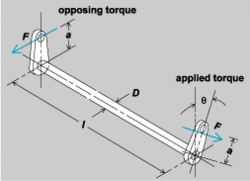Torsion beam suspension
Torsion beam suspension, also known as a torsion bar or torsion spring suspension, is a vehicle suspension system. One end of a long metal bar is attached firmly to the vehicle chassis; the opposite end terminates in a lever, mounted perpendicular to the bar, that is attached to the axle of the suspension arm or wishbone. Vertical motion of the wheel causes the bar to rotate along its axis and is resisted by the bar's torsion resistance. The effective spring rate of the bar is determined by its length, diameter, and material.
Torsion Bar Suspensions are currently used on trucks and SUV's from Ford, GM and Dodge. Manufacturers change the torsion bar or key to adjust the ride height, usually to compensate for heavier or lighter engine packages. While the ride height may be adjusted by turning the adjuster bolts on the stock torsion key, rotating the stock keys too far can bend the adjusting bolt and (more importantly) place the shock piston outside the standard travel. Over-rotating the torsion bars can also cause the suspension to hit the bump stop prematurely, causing a harsh ride. Aftermarket forged torsion key kits use re-clocked adjuster keys to prevent over-rotation, as well as shock brackets that keep the piston travel in the stock position.
The main advantages of torsion beam suspension are durability, easy adjustability of ride height, and small profile along the width of the vehicle. It provides a longer travel than leaf spring systems, and takes up less of the vehicle's interior volume compared to coil springs. A major disadvantage is that torsion bars, unlike coil springs, usually cannot provide a progressive spring rate, forcing designers to compromise between ride quality and handling ability - progressive torsion bars are available, but at the expense of durability since they have a tendency to crack where the diameter of the bar changes. In most torsion bar systems, especially Chrysler's, ride height (and therefore many handling features) may be adjusted by bolts which connect the torsion bars to the steering knuckles and require nothing more than crawling under the car with a wrench in hand. In most cars which use this type of suspension, swapping torsion bars for those with a different spring rate is usually an extremely easy task.
Some vehicles use torsion bars to provide automatic leveling, using a motor to tighten the bars to provide greater resistance to load and, in some cases (depending on the speed with which the motors can act), to respond to changes in road conditions. Height adjustable suspension has been used to implement a wheel-change mode where the vehicle is raised on three axles and the remaining wheel is lifted off the ground without the aid of a jack.
Before World War II, the front wheel drive Citroen Traction Avant (1934) had independent front torsion bar suspension and a trailing dead axle, also sprung by torsion bars. The Czechoslovakian Tatra cars designed by Professor Hans Ledwinka in the mid 1930s used all round independent torsion bar suspension, along with air cooled rear engines. Also in the 1930s, prototypes of the first Volkswagen Beetle incorporated torsion bars - especially its transverse mounting style. Ledwinka's concept had been copied by Ferdinand Porsche, whose successors later had to acknowledge the influence of Ledwinka's Tatra models on the Porsche-designed Kdf-Wagen of 1938 (later known as the VW Beetle), a post-war lawsuit resulting in a DM3,000,000 settlement paid by Volkswagen to Ringhoffer-Tatra in 1961.
The system was applied to many new armoured fighting vehicle designs during the Second World War. It was used extensively in European cars Renault, Citroen and Volkswagen, as well as by Packard in the 1950s. The Packard used torsion bars at both front and rear, and interconnected the front and rear systems to improve ride quality. The most famous American passenger-car application was the Chrysler system used beginning with the 1957 model year, although Chrysler's "Torsion-Aire" suspension was only for the front; the same basic system (longitudinal mounting) was maintained until the 1981 introduction of the K-car. A reengineered torsion beam suspension, introduced with the 1976 Dodge Aspen, introduced transverse-mounted torsion beams (possibly based on the Volkswagen Type 3 passenger car) until production ended in 1989 (with Chrysler's M platform). Light-duty Dodge trucks however continue to use torsion bars on their front suspension.
General Motors has used torsion bars since 1966, starting with the E-platform vehicles (Oldsmobile Toronado, Cadillac Eldorado), 4 wheel drive S-10 pickups, and since 1988, full size trucks (GMT400, GMT800, and GMT900 series).
Some front-wheel drive automobiles use a type of torsion bar suspension, usually called a Twist-beam rear suspension, in which the rear wheels are carried on trailing arms connected by a laterally mounted torsion beam. The torsion beam functions both as wheel-locating arm and as an anti-roll bar to resist lateral motion of the wheels as the body leans in turns. Its advantages are that it is inexpensive to manufacture and install, and engages a minimum amount of interior volume, leaving more space for the carriage of passengers, cargo, and other components. Because the torsion bar acts in the lateral plane, not vertically, the twist-beam axle cannot provide ride-height adjustment, and it suffers, to some extent, similar car handling limitations as other beam axle suspensions. However these limitations may not be apparent on the road, because of the trend towards firmer, more sporty suspension setups with more limited wheel travel. Twist-beam rear suspensions were pioneered on the Volkswagen GolfTemplate:Fact in the early 1970s, and remain common on compact cars and minivans.
External links
